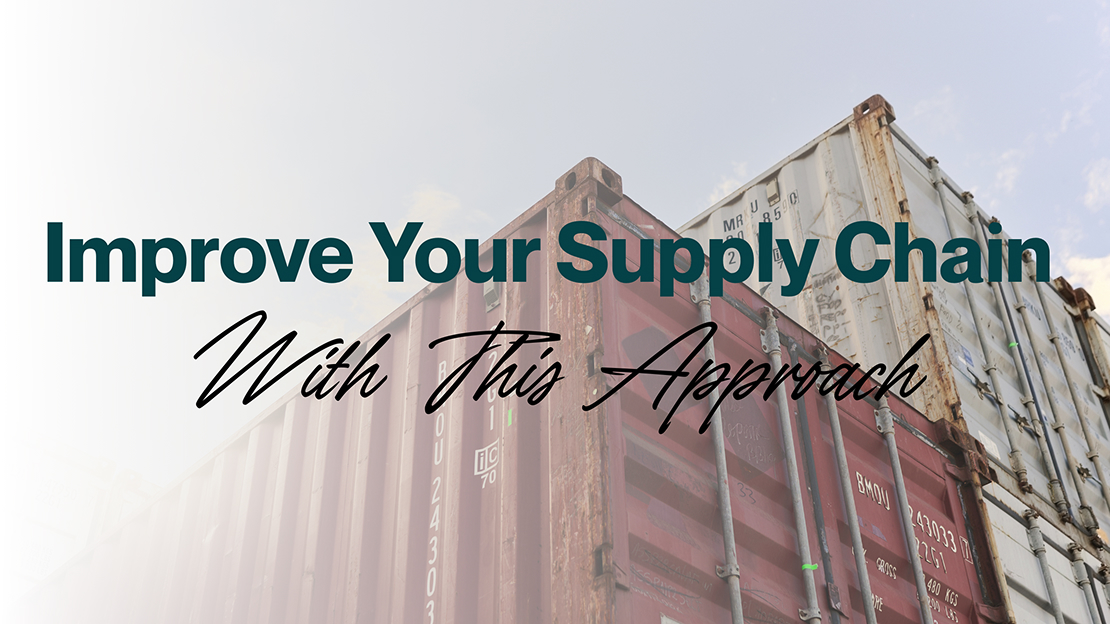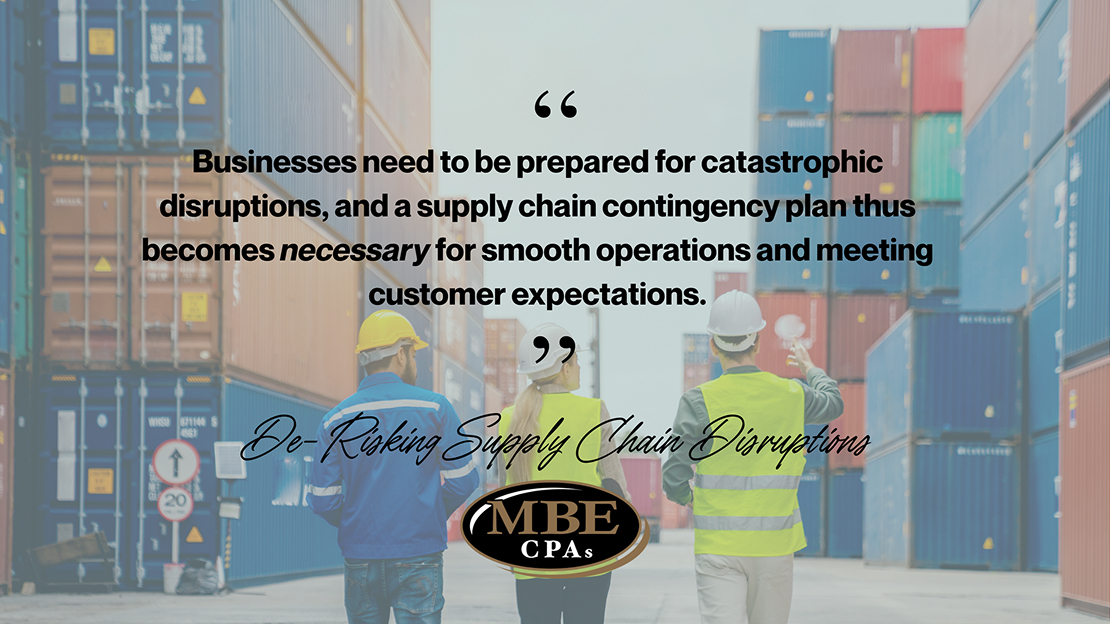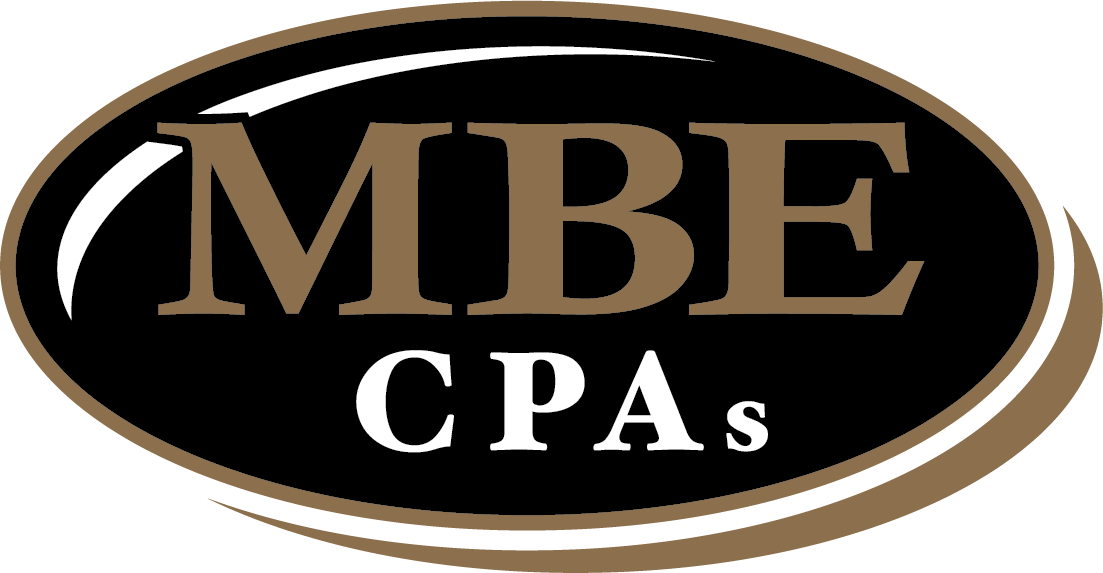Improve Your Supply Chain with This Approach

Authored by: Amy Gumtz — Partner, CPA | Date Published: September 15, 2025
Your business should operate with a continuous flow, even with waves of high and low demand. With the business environment becoming increasingly unpredictable, any unforeseen disruption can have life-long impacts on your company’s future. Being able to identify potential threats can save you, which is why contingency planning is a strategy your business needs.
MBE CPAs can help you invest in the right tools and implement the right practices so your operations can continue flowing and growing. Ask yourself: Are you equipped to improve your risk mitigation and identify disruptions in your business?
Featured Topics:
Identifying Supply Chain Disruptions
Your phone rang this morning: your main supplier’s factory flooded over the weekend, and your orders can’t be fulfilled for the next three months. Now imagine the domino effect on your operations, all because your eggs are in one supplier’s basket.
Unavoidable events like supplier failure, natural disasters, or transportation issues are what we call supply chain disruptions. Ignoring these potential disruptions can cause disastrous changes in operations, proving that effective supply chain management is essential.
One of the largest examples of unpredictable supply chain disruptions was the COVID-19 pandemic. Vulnerabilities within manufacturing were exposed, highlighting the industry’s dependence on reliable shipping and predictable supply chains.
Top risks for supply chain management:
- Internal: Issues within the business, including manufacturing, internal business, planning and control, and mitigation and contingency. Issues with machinery can cause production delays, or inadequate quality control can delay the supply chain. All of these can be prevented with a contingency plan.
- External: These threats are outside the business, including supply and demand, environmental, and external business. Natural disasters or geopolitical factors can result in material delays, causing supply chain issues. Changes in external entities that are part of the supply chain are external issues, such as business acquisitions.
- Financial: Businesses should know the value of their properties and the specific tax requirements and regulations that apply to their operations. Understanding the rules is critical to weighing potential dangers and costs to your business, especially when operating in other countries.
These scenarios aren’t just hypothetical nightmares; they are real disruptions that can reduce revenue, market share, and production, which affects your company’s bottom line. The difference between your business just getting by and thriving comes down to whether your business takes a proactive or reactive approach.
Whether you run a global or small corporation, you need the proper strategy and coverage to protect against supply chain failure.
What is Contingency Planning?
Remember how you set up an emergency fund for your personal finances? Your supply chain needs the same kind of safety net. Contingency planning is creating a model to understand the financial impact of dual-sourcing, inventory buffers, and alternative transportation methods. In simple terms, contingency planning is establishing a Plan B and the steps to be taken if disaster strikes. When disaster strikes (and it will), you’ll be ready to execute your plan instead of scrambling to find alternatives while your customers take their business elsewhere.
Supply chain disruptions are inevitable, but a strong contingency plan can allow your business to be more resilient to the changing conditions. By implementing strategic practices of contingency planning, you can mitigate the impacts of supply chain disruptions.
Here are some contingency best practices:
- Invest in Software Solutions: A clear understanding of your current supply chain structure includes having centralized data management and powerful analytics. Businesses can utilize past data to identify weak processes and where to implement supply chain contingencies. This kind of technology helps businesses spot potential challenges and respond swiftly in stressful situations.
- Start with an Assessment: No two companies will prioritize these threats the same, but analyzing suppliers using different scenarios will allow you to consider the factors necessary to identify and mitigate potential disruptions. Knowing your weak points before they break means running through different “what-if” scenarios and asking your business the tough, but necessary questions.
- Prioritize Versatility and Agility: Diversifying your supply chain operations by combining and using different modes of transport, routes, ports, and sourcing locations allows your needs to be met in case of an emergency. Businesses can also collaborate closely with suppliers and cross-train teams in all departments to reduce inefficiencies before any disruptions take place.
- Continue Testing: Scheduling regular testing of disruption scenarios helps your business evaluate where changes need to be made in production. Choosing whether to devote additional resources or improve efficiency within the supply chain is a well-prepared measure that allows you to attack these problems before they occur.
These practices aren’t just academic exercises but are necessary investments in your business’s survival. Developing your planning capabilities may require professional recommendations in both financial modeling and industry-specific factors.
Consulting with specialized accounting professionals and advisory services may be an invaluable asset to your organization.
How to Use Scenario Planning
From geopolitical conflicts to rising customer expectations, manufacturers now face challenges that make traditional approaches to supply chain planning insufficient. Scenario Planning is when businesses develop financial models to understand the impact of various disruption scenarios on their profitability and liquidity.
Manufacturers know they need backup plans, but they aren’t sure which scenarios to prepare for. Scenario planning differs from contingency planning by creating three or four future scenarios, with both good and bad outcomes, to make real decisions about the future. Should you prepare for another pandemic? A port strike? What about your biggest supplier getting acquired? Focus your limited time and resources on the scenarios most likely to impact your specific operation by using the best available algorithms to find the most suitable plan.
Effective scenario planning involves:
- Diversification strategies: When a business spreads their investments across various asset classes, industries, and regions, they can prevent over-reliance on a single source.
- Financial management: Organizations anticipate potential future events and their impact on financial performance. This includes identifying economic shifts, regulatory changes, and market trends to develop strategies for mitigating hazards and taking advantage of opportunities.
- Partnership and collaboration: By joining organizations, both companies can take advantage of opportunities like collective bargaining power, marketing cooperatives, and shared resources.
Scenario planning explores potential “what if” situations to inform future planning decisions. Approaching your operations as the devil’s advocate and analyzing both positive and negative outcomes can help uncover disruptions that you may not have seen since production is flowing so smoothly.
Key situations to question and evaluate:
- What if demand exceeds expectations?
- What if a key supplier faces disruptions?
- What if new regulations change trade routes?
- What if we need to adjust capacity for seasonal peaks?
Once you’ve established your contingency and implementation strategy, consider how comprehensive insurance coverage can provide an additional layer of financial protection against supply chain disruptions. It’s important to fill the gaps where your contingency planning can’t reach.

Insurance Implications You Should Know
When your supplier’s facility floods or your transportation route shuts down, your business can face years of recovery from a supply chain failure. Losing the trust of your buyers from this kind of ripple effect can be more devastating than the disruption itself.
Supply chain insurance provides coverage for business interruption caused by disruptions to the supply chain. A key type of insurance to consider is Contingent Business Interruption (CBI) Insurance, a policy that covers lost income from a supplier or customer experience that led to disrupted operations.
Implementing robust assessments can provide coverage for business interruption, but having insurance coverage that extends beyond traditional property damage is incredibly important.
Supply chain insurance can cover losses caused by a wide range of events:
- Natural disasters
- Industrial accidents
- Production process problems
- Geopolitical factors
- Public health emergencies
Having a trusted insurance professional can be a valuable resource in helping your business identify threats and secure adequate coverage. Securing financial protection before disruptions occur is important, but the most effective management strategies combine insurance coverage with forward-thinking scenario planning to minimize both the likelihood and impact of supply chain failures.
Understanding your business needs will allow you to anticipate dangers correctly and timely.

How MBE CPAs Can Help
You might discover that your plan has some serious holes that need fixing, and that’s where we can help. At MBE CPAs, we understand that effective supply chain contingency planning requires both financial experience and industry-specific knowledge. Our team helps businesses develop comprehensive management strategies that protect both profitability and cash flow during disruptions.
Our services include:
- Financial Planning & Analysis
- Risk Management Support
- Growth Strategy Development
- Business Consulting & Advisory
Our comprehensive approach ensures that your supply chain contingency planning is not just reactive crisis management, but positions your business for long-term success.
Being preemptive with your supply chain management can help mitigate delays, ensure business continuity, and prevent unforeseen crisis events. Our advisors can help lead this charge with their skills in turning potential disruptions into measurable business impacts.
Conclusion
How you react when calamity strikes comes down to the preventive measures your business develops now. If you have a solid contingency plan in place, you’re not panicking. By investing in supply chain strategies, you’ll spend less time worrying about potential disruptions to your operations and more time focusing on building an agile, resilient, and competitively powerful business.
The difference between businesses that react to disruptions and those that master them is anticipatory turmoil assessment, strategic financial planning, and the flexibility to adapt quickly to changing conditions. Whether you’re facing challenges from external suppliers or internal inefficiencies, the right planning approach can help your business not just survive but thrive in an uncertain environment.
Receiving guidance from a professional advisor can help you identify the best strategy for your business’s unique needs, keeping your operations equipped for the changing environmental factors.
Ready to plan your contingency strategy? Contact MBE CPAs today to develop a comprehensive contingency plan that is tailored to your industry and transforms your vulnerabilities into strengths.
